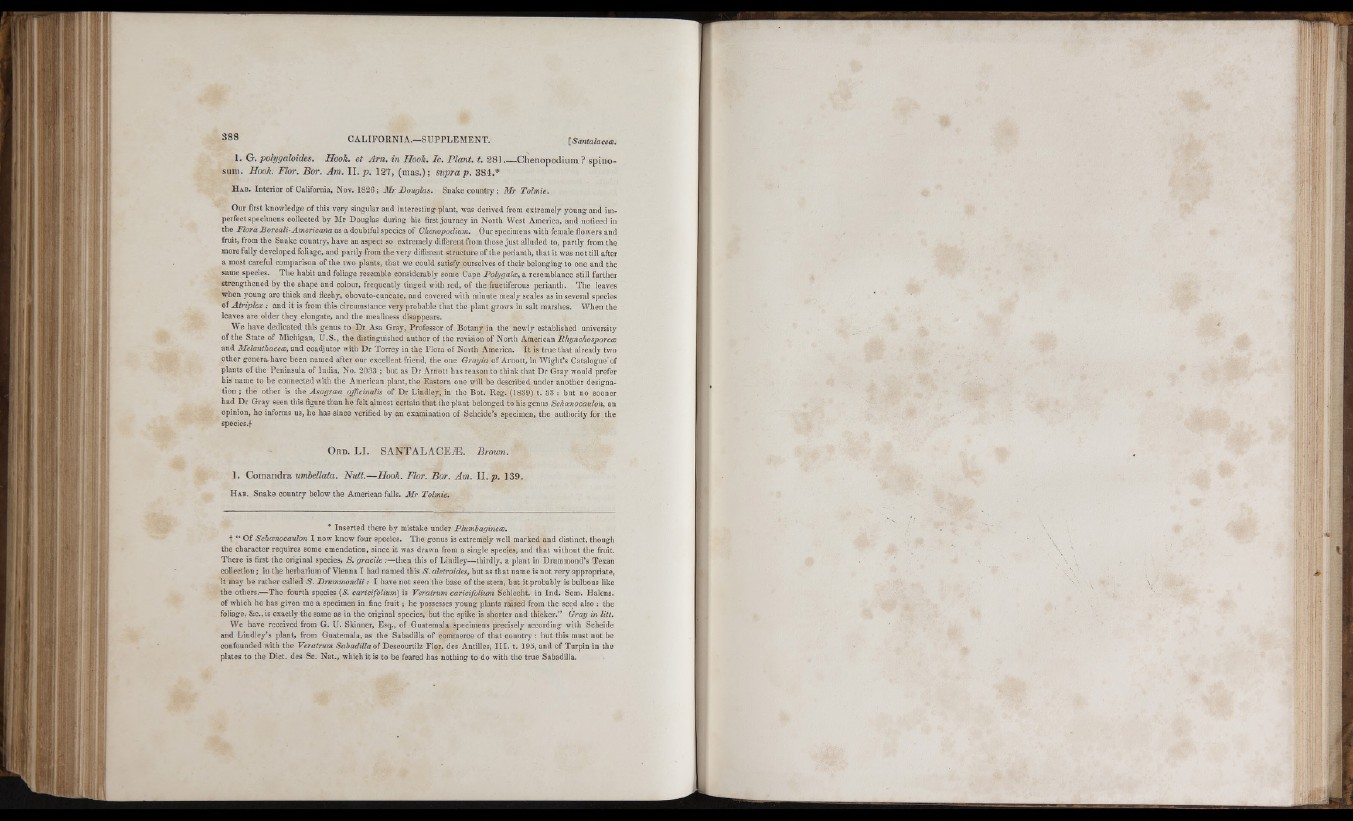
l l J f
1. G. polygaloides. Hook, et Arn. in Hook. Ic. Plant, t. 2 81.— Ch en o p o d ium? sp in o sum.
Hook. Flor. B o r . Am . I I ./? . 127, (mas.); snpra p . 384.*
H a b . Interior of California, Nov. 1826; M r Douglas. Snake country ; M r Tolmie.
Our first knowledge of this very singular and interesting plant, was derived from extremely young and imperfect
specimens collected by Mr Douglas during his first journey in North West America, and noticed in
the Flora Boreali-Americana as a doubtful species of Chenopodium. Our specimens with female flowers and
fruit, from the Snake country, have an aspect so extremely different from those just alluded to, partly from the
more fully developed foliage, and partly from the very different structure of the perianth, that it was not till after
a most careful comparison of the two plants, that we could satisfy ourselves of their belonging to one and the
same species. The habit and foliage resemble considerably some Cape Polggaloe, a resemblance still further
strengthened by the shape and colour, frequently tinged with red, of the fructiferous perianth. The leaves
when young are thick and fleshy, obovato-cuneate, and covered with minute mealy scales as in several species
of Atriple x : and it is from this circumstance very probable that the plant grows in salt marshes. When the
leaves arc older they elongate, and the mealiness disappears.
We have dedicated this genus to Dr Asa Gray, Professor of Botany in the newly established university
of the State of Michigan, U.S., the distinguished author of the revision of North American Rhynckosporeoe
and Melanthiaceoe, and coadjutor witli Dr Torrey in the Flora of North America. It is true that already two
other genera have been named after our excellent friend, tho ono Grayia of Arnott, in Wight’s Catalogue'of
plants of the Peninsula of India, No. 2033 ; but as Dr Arnott has reason to think that Dr Gray would prefer
his name to be connected with the American plant, the Eastern one will be described under another designation
; the other is the Asagrcea officinalis of Dr Lindley, in the Bot. Reg. (1839) t. 33 : but no sooner
had Dr Gray seen this figure than he felt almost certain that the plant belonged to his genus Schoenocanlon, an
opinion, he informs us, be has since verified by an examination of Schelde’s specimen, the authority’ for the
species.f
O r d . L I . S A N T A L A C EÆ . B rown.
] . Coman d ra umbellata. N u tt.— Hook. Flor. Bor. Am. I I . p . 139.
H a b . Snake country below the American falls. M r Tolmie.
* Inserted there by mistake under Phmbaginece.
+ “ Of Schanocaulon I now know four species. The genus is extremely well marked and distinct, though
the character requires some emendation, since it was drawn from a single species, and that without the fruit.
There is first the origmal species, S . gracile .— then this of Lindley—thirdly, a plant in Drummond’s Texan
collection; in the herbarium of Vienna I had named this S . aletroides, but as that name is not very appropriate,
it may be rather called S . Drummondii; I have not seen the base of the stem, but it probably is bulbous like
the others.—The fourth species {S. caricifolium) is Veratrum caricifolium Schleeht. in Ind. Sem. Halens.
of which he has given me a specimen in fine fru it; he possesses young plants raised from the seed also ; the
foliage, &c., is exactly the same as in the original speeies, but the spike is shorter and thicker.” Gray in litt.
We have received from G. U. Skinner, Esq., of Guatemala specimens precisely according with Scheide
and Lindley’s plant, from Guatemala, as the Sabadilla of commerce of that country : hut this must not be
confounded with the Veratrum Sabadilla of Descourlilz Flor. des Antilles, I I I . t. 195, and of Turpin in the
plates to the Diet, des Sc. Nat., which it is to be feared has nothing to do with the true Sabadilla.
■|?f •
1
î i | | ^
'HI i*
J
t o y i i